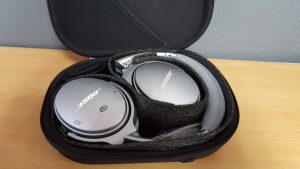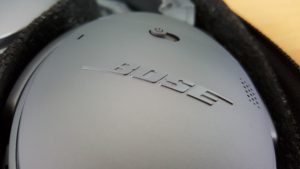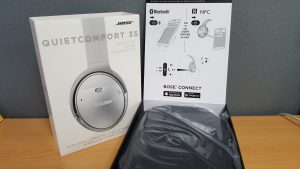When people talk about audio manufacturers often the top names mentioned include Sennheiser, Sony, Audio Technica and Bose. They don’t offer cheap “good enough” products to users; they build products that give the users the best experience possible and they expect that.
I listen to a lot of music, usually about 3 – 5 hours a day while I’m at work and because of that I have some fairly particular wants and needs when it comes to headphones. I need them to be really comfortable, soft and light on my head. I wear glasses all the time, so this can be troublesome with on ear headphones putting pressure on the back of my ears over the arm of my glasses. I’m eclectic with my music tastes depending on the given day, so a targeted product often doesn’t work for me as they’re tuned for a specific genre of music. With my wants and needs, added to my history of spending many hours listening to various headphones before purchasing and maybe spending too much on them, it’s not an easy task for headphones to impress me.
Hardware
When it comes to headphones it’s really easy to see that they’re headphones, revolution isn’t something that comes in the form of design these days. They sit on your head and depending on your preference either on or over your ears and they make noises that you choose and find pleasing.
Where the basic concept is simple and easy to delivery, the better known names have taken the aesthetics of their hardware further than others and make pleasing to look at headphones that offer users a level of comfort and experience that (in most cases) justifies paying hundreds of dollars versus fifty.
Where the Bose hardware at an AU$499 RRP stands out over the sub $100 variety is the quality of build and supporting accessories that you just don’t get with the cheaper gear.
Opening the hard carry case which is designed to protect your headphones for the first time, even the case is really nicely made. You’ll see that the headphones fit perfectly with the layout also including an airline adaptor, soft netting to hold the charging cable and the 3.5mm cable for when you’re not connecting wirelessly.

All of the looks are great, but when you take the QC35 out of the case to use them the first time you realise very quickly where your extra cash goes. We already mentioned that the cans are hinged from the over head band and the hinges feel really solid. They don’t bend or twist in any way they’re not clearly designed to do, with metallic inlays in the hinges and the extension for the headband adding to the strength of them.
Despite having metallic components, Bose have managed to maintain the lightweight feel that you would expect from an expensive set of headphones. I’ve had headphones in the past that cost a significant amounts of money that I just wasn’t happy with ultimately, they sounded good but were heavy and cumbersome after a while or went the other way and weren’t particularly well built and cost significant amounts of time and distress chasing warranties when they broke.

Finally we have the bluetooth link between your devices which on the QC35 is as simple as it gets. Turn the headphones on and link your device to the headphones. What’s particularly useful is the ability to link multiple devices to your headphones simultaneously so I have linked both my mobile phone and Macbook to give the full range of functionality. Even when connected to 2 devices all day (through working hours) and during some evening playback, I got 2 full days repeatedly from them. I’d happily say that the battery exceeds the claims of Bose and I would put the playback time at close to 20 hours before requiring recharging.
What all of this means is that they’re comfy, feel quite durable (only a longer time with them will know for sure), either wired or wireless links are possible and there is sufficient protection for your investment during travel or when they’re stored in your bag so let’s get onto the really important bit of headphones.
Sound
When I reviewed the Bose QC25 back in 2014 I was a bit critical of the lack of sound depth at low volume but the sound itself did leave quite an impression once they were up to a normal listening level. The QC35 are a fairly significant step forward from the older model, not only in capability (built in battery and wireless connectivity) but also in the sound delivery.
There’s a saying that many people will have heard – “No highs, no lows – must be Bose” which in case of some of their older gear is fair, but the QC35 have belted that one out of the park either with or without the Noise cancelling turned on.
I work at a software development house, so it is generally a very quiet workplace with nothing but the soothing taps of keyboards and the general hum of our air-conditioner. It’s not a lot of noise to get rid of but two things struck me every time I took the headphones off during the day. The first is just how much background noise there is in the works and the second is how good a job Bose have done at eliminating it. Even walking along a major road in Adelaide, it was like having your own little bubble to live in which was really pleasant.
What I really enjoyed with these was heading detail in music that isn’t normally audible because of some of the static noise in the world around us as well as adding the quality that Bose offer.

I’ll listen to almost anything by way of music and generally enjoy it (no boy bands, Bieber or generic ‘pop’ though) so Bose gear generally suits my needs and this time around they’ve done exceptionally well. The QC35 are getting done great reviews around the internet and I know why. They have some really crisp, dynamic high range without being sharp to the ears. The mid-range is full and immersive and the bass is really impressive, packing a solid punch. For some users though, there will be a problem with the bass.
I found this when I was listening to Pendulum, loving the song so I wound it up. Then I heard that horrible flat ‘fart’ you get when the music is quite bass heavy and you’re asking more of speakers than they’re capable of. To be very clear about this, I do not believe this is something that all users will find or experience. This was only audible on a particularly bass heavy track when I had the volume up at a level that I’d call “uncomfortably loud”. Even at a more human listening level with various music genres, this wasn’t an issue at all. In fact when you turn on the noise cancelling and turn the volume up, The QC35 provide one of the fullest sound experiences I have had with a pair of headphones without spending (while these are expensive) truly obscene amounts of money.
I’ll be quite blunt here, if you’re buying these headphones and not using the noise cancelling you have wasted money! While they do work without the noise cancelling turned on, I found that the sound dynamic wasn’t anywhere near as good without a it lost some of the sound dynamic of high range, seemed to lose much of the low range punch but did maintain a more than acceptable mid range sound quality. Having said all of that, it is worth noting though that the ability to listen without the noise cancelling is only available when you’re hard wired to your source device which is required if you’re in areas that don’t allow wireless devices such as air travel.
So the big questions after all of this information is “are they worth the $499 cost?”
They’re really impressive, offer a great experience for all users regardless of what you’re doing – music, podcasts or watching videos and to be honest I believe Bose have gone so close to absolutely nailing it. The QC35 are really comfortable, lightweight and offer great sound but for the average user it would be really hard to justify the cost thats for sure. For users who listen to a lot of music, commuters who travel to work daily in a noisy environment such as bus or train or even those to travel by air regularly these would be a fantastic investment. If the price tag a deterrent for you you should keep your eyes on the big and even online retailers that regularly run specials on equipment like headphones you’ll probably land yourself a bargain.
If you’re looking for a new set of headphones, what do you look for before dropping the cash?





How does the noise cancelling ability on these compare to the Sony H.ear you guys just reviewed?
I’ll let you know when the Sony’s arrive
or Chris when the QC35 arrive to him 🙂
Good question Daniel; we’re preparing a Sony v Bose comparison, which we’ll be publishing probably by the end of the week / over the weekend, as soon as the headsets make their way across the country between SA and NSW 🙂
Thanks for a great review … Only recently got my Zik 3.0 (excellent other than a few bluetooth jankiness issues), otherwise would be trying out a set of these
I own the QC25 and would consider buying these. But I have two questions that went unanswered in this review: (1) does the internal wiring tend to break like the QC25? With the QC25 people (including myself) have gone through multiple sets, because one of the ear-speakers wiring fails; and (2) does the Bluetooth work, or is it regularly dropped or confused, especially on public transit. Bluetooth is always trouble, but moreso where there are many competing channels.
I didn’t have enough time to tell you honestly if the wiring will hold up to long term use. They do feel more solid than the 25s.
The bluetooth was really solid around my house, workplace and even in public area’s I didn’t have any issues with dropouts.
I’m kinda interested in these, but the question I always gave for wireless headphones is sound quality when on Bluetooth. Can you comment on any difference in sound quality comparing wired to wireless.
It depends on source device.
Older devices with say BT2.0 will have lower quality sound to those with A2DP unless you’re a complete audiophile with way better hearing that the average person, you won’t hear the difference between wired and wireless.
The newer Bluetooth codecs aptX (Qualcomm) and LDAC (Sony) won’t degrade the sound quality, plus they will allow you to stream hi res files via BT.
With older BT profiles, 2.0, A2DP etc (or any without aptX or LDAC), there was a drop in the sound quality compared to ‘wired sound’.
aptX and LDAC = no drop in quality compared to wired. Obviously both the audio source and your earphones need to support the codecs to take advantage of this.